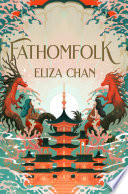 Fathomfolk by Eliza Chan
Fathomfolk by Eliza Chan Series: Drowned World #1
Published by Orbit on February 27, 2024
Genres: Fantasy
Pages: 448
Format: ARC
Source: Received from publisher
Goodreads

Revolution is brewing in the semi-submerged city of Tiankawi, between humans and the fathomfolk who live in its waters. This gloriously imaginative debut fantasy, inspired by East Asian mythology and ocean folk tales, is a novel of magic, rebellion and change.
Welcome to Tiankawi - shining pearl of human civilization and a safe haven for those fleeing civil unrest. Or at least, that's how it first appears. But in the semi-flooded city, humans are, quite literally, on top: peering down from shining towers and aerial walkways on the fathomfolk - sirens, seawitches, kelpies and kappas - who live in the polluted waters below.
For half-siren Mira, promotion to captain of the border guard means an opportunity to help her downtrodden people. But if earning the trust and respect of her human colleagues wasn't hard enough, everything Mira has worked towards is put in jeopardy when Nami, a know-it-all water dragon and fathomfolk princess - is exiled to the city, under Mira’s watch. When extremists sabotage a city festival, violence erupts, as does the clampdown on fathomfolk rights. Both Nami and Mira must decide if the cost of change is worth paying, or if Tiankawi should be left to drown.